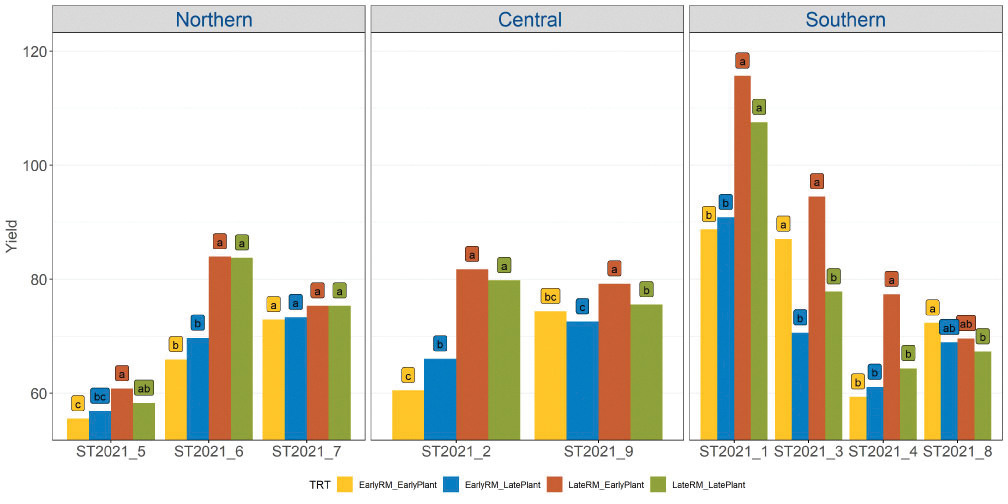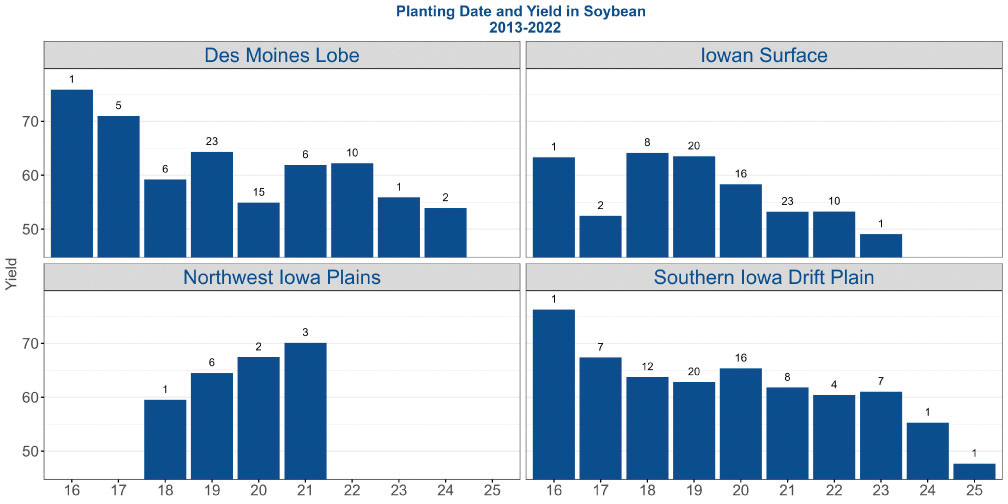Using data to increase on-farm productivity and profitability
December 1, 2023 | Matthew Carroll, PhD
December is a great time to reflect on what went well the past year, and what can be improved in the year ahead. As you think about making your game plan for 2024, I encourage you to consider soybean planting dates and relative maturities that are right for your farm.
Iowa Soybean Association (ISA) invests checkoff dollars each year to help fund the North Central Soybean Research Program (NCSRP) to help increase collaborative research across the north central soybean growing states. ISA’s Research Center for Farming Innovation (RCFI) also collaborates with many of these researchers to help validate on-farm trials.
University of Wisconsin researchers started working on the project “Using Data-Driven Knowledge for Profitable Soybean Management Systems” in 2019. Researchers used an online survey to ask farmers across the Midwest about their management practices for soybean fields, and the corresponding yields for each field. The management data received from this survey work was inputted into a machine learning algorithm to make region-specific management recommendations.
The researchers found that the two most important variables that predicted yield were planting date and latitude. As a grower, you can change your planting date, but unless you plan to move your farm, latitude is something we cannot control.
Other important variables were soybean maturity groups and applying a foliar fungicide and insecticide. The algorithm recommendations varied by state, but all scenarios recommended planting soybeans earlier. In Iowa, the additional recommendations were to plant a later maturity group, preferably 3.6 or greater, apply a foliar fungicide and insecticide and have a planting population of 130,000 seeds per acre.
On-farm trials
In 2021, ISA put the algorithm to the test with farmer-cooperators in nine locations throughout the state. We tested fields with four treatments: early maturity and early planting, early maturity and late planting, late maturity and early planting, and late maturity and late planting.
Across all sites, late maturity with an early planting date was a top-performing treatment. When the analysis was combined across all locations, early planted beans with a later maturity were significantly different, with an average yield of 81 bushels per acre — beating the next closest treatment of early maturity with late planting by five bushels an acre.

Trials with different letters were statistically different nine out of 10 times. The grouping letter "a" represents the top-performing yield treatment at each location. Using a later maturing variety and earlier planting dates showed no yield loss and yield gain in many locations compared to other treatment combinations.
Late maturity varieties
We see similar trends when we break this down by just relative maturity and planting date; seven of the nine sites saw benefits from using a later maturity variety. There did not appear to be any additional benefit based on latitude of the trial locations. Across all locations, the late maturity groups averaged 79 bushels per acre, and the early maturing varieties averaged 70 bushels per acre.
Planting date had a slightly different trend, with no counties in northern Iowa seeing a yield benefit from early planting. Four of the nine sites saw a benefit to earlier planting dates, with these sites being in central and southern Iowa. Across all locations, there was a significant effect of planting date with an average yield of 76 bushels per acre for early planted beans and 73 bushels for late planted.
Interestingly, what was found to be the most significant factor to increase yield in this trial was planting longer maturity varieties regardless of location across the state. The key takeaway that I would stress is that the improved system never lost yield for farmers and has a lot of potential upside, with an average yield gain of 5 bushels an acre.

The x-axis shows the week a trial was planted, with the 16th week of the year being around April 15. The numbers above each bar represent the number of trials for each data point.
Conclusions
In addition to this study, we looked at 239 soybean on-farm research trials from 2013 to 2022. What we found agreed with the meta-analysis from Wisconsin. Planting earlier provides a yield advantage across the state. Interestingly, when we break this down by landform region, most of the areas of the state see this response, but in Northwest Iowa, growers may want to consider not pushing early planting dates.
Back